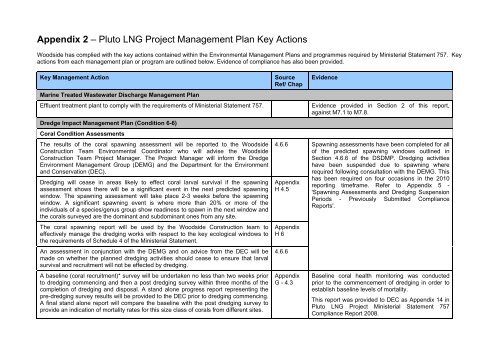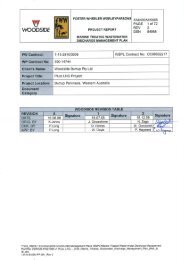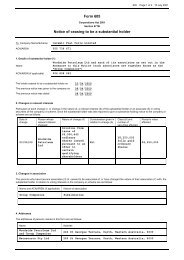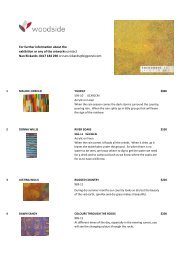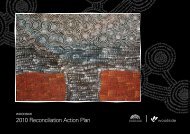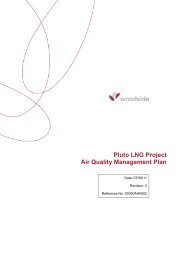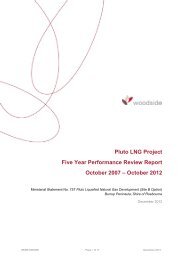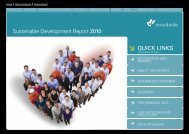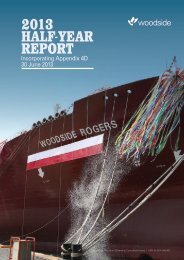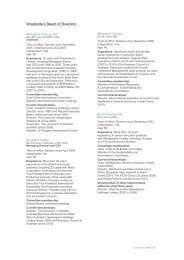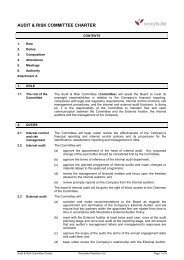Appendix 2 â Pluto LNG Project Management Plan Key ... - Woodside
Appendix 2 â Pluto LNG Project Management Plan Key ... - Woodside
Appendix 2 â Pluto LNG Project Management Plan Key ... - Woodside
Create successful ePaper yourself
Turn your PDF publications into a flip-book with our unique Google optimized e-Paper software.
<strong>Appendix</strong> 2 – <strong>Pluto</strong> <strong>LNG</strong> <strong>Project</strong> <strong>Management</strong> <strong>Plan</strong> <strong>Key</strong> Actions<strong>Woodside</strong> has complied with the key actions contained within the Environmental <strong>Management</strong> <strong>Plan</strong>s and programmes required by Ministerial Statement 757. <strong>Key</strong>actions from each management plan or program are outlined below. Evidence of compliance has also been provided.<strong>Key</strong> <strong>Management</strong> ActionMarine Treated Wastewater Discharge <strong>Management</strong> <strong>Plan</strong>SourceRef/ ChapEvidenceEffluent treatment plant to comply with the requirements of Ministerial Statement 757. Evidence provided in Section 2 of this report,against M7.1 to M7.8.Dredge Impact <strong>Management</strong> <strong>Plan</strong> (Condition 6-6)Coral Condition AssessmentsThe results of the coral spawning assessment will be reported to the <strong>Woodside</strong>Construction Team Environmental Coordinator who will advise the <strong>Woodside</strong>Construction Team <strong>Project</strong> Manager. The <strong>Project</strong> Manager will inform the DredgeEnvironment <strong>Management</strong> Group (DEMG) and the Department for the Environmentand Conservation (DEC).Dredging will cease in areas likely to effect coral larval survival if the spawningassessment shows there will be a significant event in the next predicted spawningwindow. The spawning assessment will take place 2-3 weeks before the spawningwindow. A significant spawning event is where more than 20% or more of theindividuals of a species/genus group show readiness to spawn in the next window andthe corals surveyed are the dominant and subdominant ones from any site.The coral spawning report will be used by the <strong>Woodside</strong> Construction team toeffectively manage the dredging works with respect to the key ecological windows tothe requirements of Schedule 4 of the Ministerial Statement.An assessment in conjunction with the DEMG and on advice from the DEC will bemade on whether the planned dredging activities should cease to ensure that larvalsurvival and recruitment will not be effected by dredging.A baseline (coral recruitment)* survey will be undertaken no less than two weeks priorto dredging commencing and then a post dredging survey within three months of thecompletion of dredging and disposal. A stand alone progress report representing thepre-dredging survey results will be provided to the DEC prior to dredging commencing.A final stand alone report will compare the baseline with the post dredging survey toprovide an indication of mortality rates for this size class of corals from different sites.4.6.6<strong>Appendix</strong>H 4.5<strong>Appendix</strong>H 64.6.6<strong>Appendix</strong>G - 4.3Spawning assessments have been completed for allof the predicted spawning windows outlined inSection 4.6.6 of the DSDMP. Dredging activitieshave been suspended due to spawning whererequired following consultation with the DEMG. Thishas been required on four occasions in the 2010reporting timeframe. Refer to <strong>Appendix</strong> 5 -'Spawning Assessments and Dredging SuspensionPeriods - Previously Submitted ComplianceReports'.Baseline coral health monitoring was conductedprior to the commencement of dredging in order toestablish baseline levels of mortality.This report was provided to DEC as <strong>Appendix</strong> 14 in<strong>Pluto</strong> <strong>LNG</strong> <strong>Project</strong> Ministerial Statement 757Compliance Report 2008.
Water Quality and Sediment Condition AssessmentsSatellite imagery from the coarse, medium and high resolution satellites will beprocessed by <strong>Woodside</strong> to provide broad scale, semi-quantitative information on theextent and intensity of turbidity within the survey area.4.6.4 MODIS images have been captured approximatelytwice a week since the commencement of dredgingand analysed to provide broad scale semiquantitativeturbidity maps. These MODIS imagesare used to aid interpretation of water quality resultsduring exceedances (refer to Condition 6-2 to 6-4).A high resolution IKONIS image was also capturedprior to dredging. ‘Rapid Eye’ and ‘IKONIS’ imageswere removed from the Remote Sensing WaterQuality Monitoring Program for Phase 2 of thedredging program as they provided limited benefitfor interpretation of in-water monitoring results andmanagement of the dredging program.Sediment samples from each site will be taken prior to dredging and again after thecompletion of dredging. If the post dredging survey shows significant change insediment characteristics, a further survey will be undertaken six months later todetermine if the sediment characteristics have returned to pre-dredge state.A report will be provided to the DEC after each (PSD)* sampling event.A key component of the monitoring programme will be an early model verificationphase in which the predictions made by the model for various sets of environmental(weather and sea state) conditions can be tested by taking real measurements in andaround the plume.4.6.3<strong>Appendix</strong> E2.6The DEMG supported the proponent’s proposal toremove these high resolution techniques from theremote sensing program.A baseline PSD analysis survey was undertaken inearly November 2007 prior to the commencement ofdredging in accordance with the approved Samplingand Analysis <strong>Plan</strong>.This survey was provided to DEC as <strong>Appendix</strong> 15 in<strong>Pluto</strong> <strong>LNG</strong> <strong>Project</strong> Ministerial Statement 757Compliance Report 2008.The post dredging survey was conducted followingthe completion of dredging in 2010 and the reportprovided to DEC.4.9 Model verification was completed during 2010.
BEP TechniquesThe specific techniques, equipment, technology and management measures that willbe implemented as part of <strong>Woodside</strong>’s commitment to BEP dredging are described inSection 4.3.4 (Table 26) of the DSDMP. These measures must be implemented wherepossible.*The effectiveness of BEP techniques will be reported to the DEMG in the event thatthey are implemented. An independent dredging expert has also been appointed to theDEMG to offer further advice where applicable.Marine Quarantine <strong>Management</strong> <strong>Plan</strong> (Condition 8-1)4.3.2 Nil dredging impact on coral health to date (refer toConditions 6-2 to 6-4) is evidence that appropriateproactive measures are being taken to reduce thepotential for impact on coral communities fromturbidity and/or sedimentation;The BEP techniques specified in the DSDMP havebeen implemented where required.4.3.4 The effectiveness of the BEP techniquesimplemented has been discussed with the DEMGwhere applicable. Meeting minutes are submitted tothe DEC DEMG Representative following eachmeeting.Quarantine <strong>Management</strong> <strong>Plan</strong> key actions. Various The key management actions relating to riskassessment and inspection/vetting of dredgingequipment and/or other vessels associated withdredging are specifically addressed underMinisterial Conditions 8-2 to 8-9. Verifiable evidenceis provided against these conditions and notrepeated here.Sea Turtle <strong>Management</strong> <strong>Plan</strong> (Condition 9-2)Development and implementation of a construction lighting protocol. Table 7-CS1Implementation of Blasting Procedures. Table 7-CS2The Construction Lighting Protocol has beensubmitted to, and approved by, DEC. The protocolis being implemented on site.Due to the success of mechanical dredgingmethods in the berth pocket and inner trunkline,only a single blast pattern was required. Thisoccurred during daylight hours on 17 October 2008without incident. The DEMG was consulted duringthe required verification process for the exclusionzone. An exclusion radius of 1000m was adopted.
Implementation of Dredging Procedures. Table 7-CS3<strong>Management</strong> of nearshore / offshore spill response plan. Table 7-CS4Limit access to Holden Beach (personnel and vehicles). Table 7-CS5Development and implementation of an operational lighting protocol. Table 8 -OS1Cultural Heritage <strong>Management</strong> <strong>Plan</strong><strong>Key</strong> actions relating to dredging works wereexamined by an Independent Fauna Observer (IFO)from Blue <strong>Plan</strong>et Marine fortnightly during the turtlenesting season (November – April). Fortnightlyreports are available at the request of DEC;<strong>Appendix</strong> 6 contains the summary report of IFOinspections between 2007 and 2010.<strong>Woodside</strong> has in place a spill response plan thatmanages the response to a marine hydrocarbonspill if one was to occur. It has not been activatedfor this work scope as no significant spills occurredduring completion of the works.Restricted access is covered in site inductions andthe area is fenced or otherwise marked to preventaccidental access.Submission of Operational Lighting Protocol toDEC. This has been approved by the DEC.Meet statutory obligations in relation to the management of cultural heritage. Section 1 Site A - Department of Indigenous Affairs confirmedcompliance. Site B - independent consultant adviceconfirms compliance.Implement where practicable the recommendations made by the Indigenous groups ofthe area in relation to cultural heritage management.Section 1 <strong>Pluto</strong> Public Environmental Review (chapters 10and 11) outline how <strong>Woodside</strong> has implementedrecommendations from the local Aboriginal groupsregarding footprint design. In addition, the localAboriginal groups are involved in an ongoingprocess of performance monitoring to assist<strong>Woodside</strong> in achieving the objectives of culturalheritage management plans for the project.Minimise impacts to the cultural heritage environment. Section 1 The majority of rock art on <strong>Pluto</strong> <strong>LNG</strong> <strong>Project</strong> leaseshas remained undisturbed. No engravings weredamaged during the relocation of rock art.Air Quality <strong>Management</strong> <strong>Plan</strong>Ensure plant emissions and the effect, if any, this has on ambient air quality is in placefor the operations phase of the <strong>Pluto</strong> <strong>LNG</strong> Development.The Air Quality <strong>Management</strong> <strong>Plan</strong> was submitted toDEC on 29 September 2010 for approval.
Greenhouse Gas Abatement ProgramOffset reservoir CO 2 emissions for the life of the project using allocation from the<strong>Woodside</strong> market abatement portfolio, to meet the environmental approval abatementconditions.Preliminary Decommissioning <strong>Plan</strong>Ensure a preliminary decommissioning plan is approved, in accordance with therequirements of condition 14-1.Final Decommissioning <strong>Plan</strong>Not applicable at this stage. The Final Decommissioning <strong>Plan</strong> will be developed closerto decommissioning date. <strong>Key</strong> actions to satisfy this commitment will be identified onceplan has been approved.6.1 A contract with CO2 Australia to biosequestercarbon dioxide is in place as the mechanism bywhich the <strong>Pluto</strong> <strong>LNG</strong> <strong>Project</strong> will discharge offsetobligations for the project.A revised preliminary decommissioning plan wassubmitted to DEC for approval on 8 January 2010and was approved on 1 February 2010. There wereno actions to undertake relating to decommissioningduring the reporting period.NA* Note: Minor additions have been made to key actions from management plans for clarification of intent.


